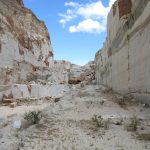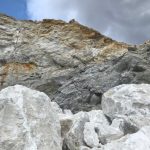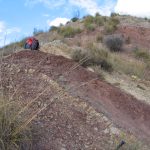Investigación y transferencia de los resultados de la investigación que se han realizado con otras entidades, públicas y privadas, según lo previsto en el artículo 83 de la Ley Orgánica de Universidades.
TRABAJOS REALIZADOS CON EMPRESAS Y LA ADMINISTRACIÓN PÚBLICA
Gestionados a través de OTRI y Fundación General Universidad de Granada-Empresa
- Empresas y Administración Pública
- - GEYTEX, Geología y Técnicas de Exploración, S.L. - 1994, 1995, 1996, 1997, 1998, 1999, 2006, 2012, 2013, 2014, 2015, 2016
- - Ayuntamiento de Cambil (Jaén) – 1994
- - Confederación Hidrográfica del Sur – 1995, 1996, 1997
- - Ayuntamiento de Santisteban del Puerto (Jaén) – 1996
- - Soluciones para el Medio Ambiente, S.L. – 1999, 2000
- - ENYPSA, Ensayos y Proyectos, S.L. - 2001, 2003, 2007
- - BPB Iberplaco, S.A. – 2005, 2006, 2007.
- - GEOMASA, S.L. 2007
- - Basalto informes técnicos, – 2008, 2012, 2016, 2017
- - Areniscas Rosales S.A. 2009
- - Saint Gobain Placo Ibérica – 2008, 2009, 2010, 2011, 2012, 2013, 2014, 2021, 2022, 2023
- - Sergeyco Andalucía, S.L. - 2008, 2010, 2011, 2012, 2018, 2019
- - Laboratorios KOVAK SC - 2007, 2010, 2013
- - Centro Tecnológico del Mármol - 2010
- - UTE Geotecnia Antequera (Adif) - 2011
- - Análisis no destructivos Atlante - 2014, 2016, 2018
- - CODEXA ingeniería y control - 2014
- - CEMOSA – 2015, 2016
- - UBAGO GROUP, 2017
- Temas y objetivos
Estudio geológico regional, Estratigrafía, Control geológico de sondeos, Geología Estructural, Interpretación geológica de subsuelo, Estudio metodológico de prospección, Petrografía, Caracterización de materiales, Caracterización y valoración de recursos geológicos, Análisis de microfacies, Patrimonio Geológico.
- Métodos, Técnicas, Medios utilizados
Cartografía geológica, estudio de campo, muestreo, sondeos de rotopercusión y rotación, estudio de testigos, registros de VLF, sondeos eléctricos verticales, tomografía eléctrica, mapas gravimétricos, mapas topográficos (1:5.000 y 1:10.000), fotografías aéreas y ortofotografías (1:10.000), microscopio petrográfico, lupa binocular, microscopio electrónico de barrido, difracción de rayos X, fluorescencia de rayos X, ICP masas, granulometrías. Métodos geofísicos llevados a cabo con empresas de prospección geofísica.
Proyecto investigación sobre metodología en la exploración de evaporitas:
Integrated Interpretation of Electrical Resistivity Tomography for Evaporite Rock Exploration: A Case Study of the Messinian Gypsum in the Sorbas Basin (Almería, Spain)
A. Pérez-López (UGR), M. García-López (GEYTEX), M. González-Gil (Saint Gobain Placo Ibérica)
Minerals 13(2):136
https://doi.org/10.3390/min13020136
Abstract: In this study, we conduct an investigation of the Sorbas Basin (Almería, Spain) on the Messinian gypsum unit using geophysical prospecting methods. Geophysical electrical resistivity tomography (ERT) methods were applied to study the subsurface of this gypsum unit, the exploitation of which could be of interest economically, with different commercial specifications for alabastrine and selenitic gypsums. For the interpretation of the different ERT images, the data for the surface geology, borehole cores, and seismic refraction conducted at a point within the ERT profiles were used. The results obtained from this investigation can be used as a reference for other similar studies in other regions. It was observed that selenitic gypsum is more resistive than alabastrine gypsum; therefore, the diagenetic processes of dehydration (anhydritization) and hydration (gypsification) increase the “percolation” phenomenon through possibly ensuring a greater connectivity of the shale matrix. Fracturing and moisture can be used to fully determine the resistivity of the purest and most resistive gypsum, to the point of considerably lowering the resistivity in an entire area affected by fracturing. The use of different tests with different lengths for the same profile can help one better understand the structure of the gypsum body in the subsurface, especially when there are shale intercalations or more- or less-pure levels of gypsum that do not reach a value of a few meters in thickness, because these thinner levels of a few meters are not defined in the ERT images when the test is performed at depths of up to 75 m.



